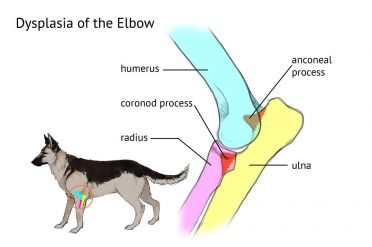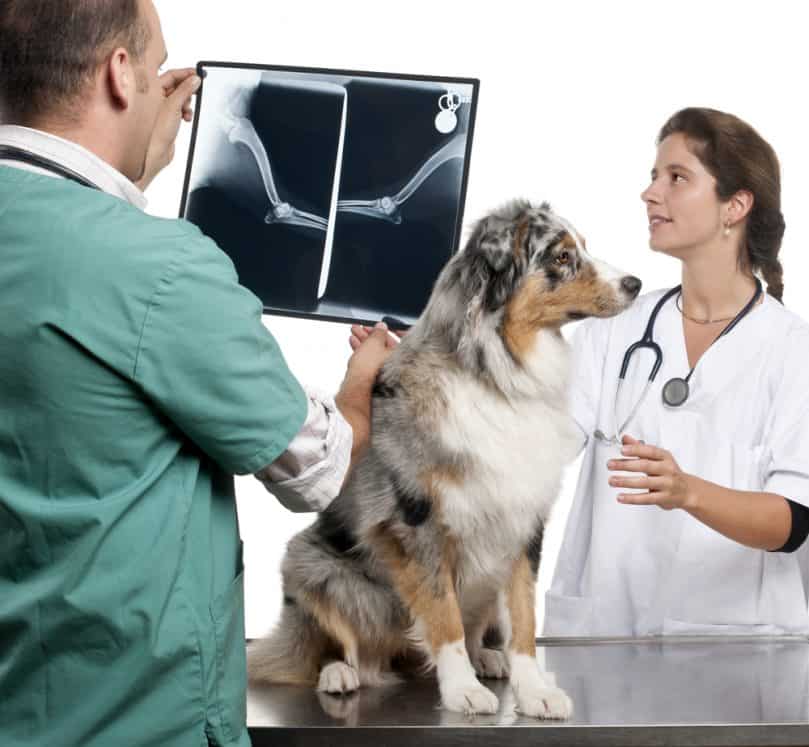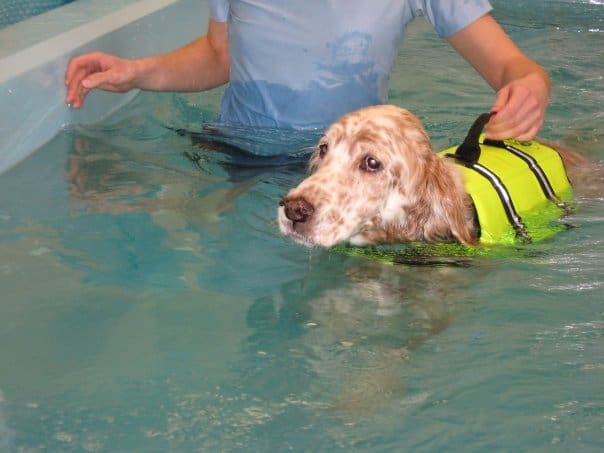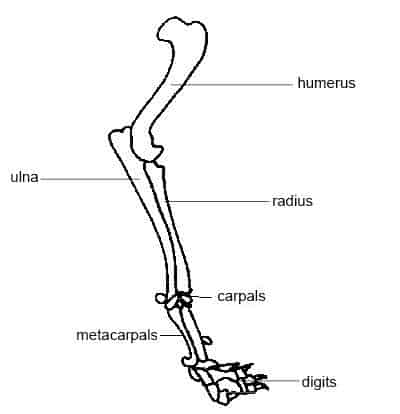This page contains affiliate links. We may earn money or products from the companies mentioned in this post through our independently chosen links, which earn us a commission. Learn More
 Elbow Dysplasia is a condition affecting the dog’s elbow-joint in the dog by multiple developmental abnormalities, including the growth of the cartilage or other surrounding structures. It will result in difficulty getting up, swollen joints, reluctancy to play or walk. Elbow Dysplasia is genetic, but diet and exercise influence the severity level.
Elbow Dysplasia is a condition affecting the dog’s elbow-joint in the dog by multiple developmental abnormalities, including the growth of the cartilage or other surrounding structures. It will result in difficulty getting up, swollen joints, reluctancy to play or walk. Elbow Dysplasia is genetic, but diet and exercise influence the severity level.
What can we do to help a beloved canine who suffers from this condition?
In this article, we will be talking about the possible causes of elbow dysplasia and the symptoms of this disease. We’ll also discuss some remedies for the condition.
Contents & Quick Navigation
What is elbow dysplasia?
Before getting into the disease itself, it’s better if we start off with discussing the healthy canine skeletal structure first.
There are three bones that makes up a dog’s elbow – the radius, the humerus and the ulna. In a healthy canine, these three bones grow and fit together to form the canine elbow joint. These bones glide and work together effortlessly when a canine is moving.
Here’s a picture of a healthy elbow joint:
When a dog has elbow dysplasia, there are developmental abnormalities in the elbow joint, resulting in the malformation of these bones and causing pain to canines that suffer from this condition.
Elbow dysplasia is a lifelong condition and is generally found in large breeds. With a very high rate of heritability, elbow dysplasia is often bilateral, but one limb can be worse than the other.
Some of the breeds that are usually affected with this condition are German Shepherds, Golden Retrievers, Labrador Retrievers, Newfoundlands, Rottweilers, English Mastiffs, St. Bernards, and Bernese Mountain Dogs.
What causes elbow dysplasia?
Developmental causes
The Orthopedic Foundation for Animals (OFA) labels three conditions under the diagnosis of elbow dysplasia. These are: fragmented medial coronoid of the ulna, osteochondritis of the medial humeral condyle in the elbow joint and ununited anconeal process.
Fragmented Medial Coronoid of the Ulna (FCP) occurs when bones in the ulna fails to properly develop and breaks off from the ulna and causes joint irritation.

White arrow: Osteoarthrosis of the ulnar bone
Yellow arrow: step between radius and ulna
Red arrow: missing cranial border of coronoid process (fragmented coronoid process)
(source)
Osteochondritis of the medial humeral condyle (OCD) is caused by abnormal or incomplete formation of cartilage. A cartilage acts as a cushion between two underlying bones making the bones glide and work together flawlessly.
In the dog’s bone structure formation, the anconeal process involves small bony projections uniting and fusing with the ulna. This process is critical in the formation of a dog’s elbow joint. Failure to complete the anconeal process results in ununited anonceal process or UAP.
Nutritional causes
There are instances when the cause of elbow dysplasia is the increased intake of nutrients that promote rapid bone growth. These nutrients, such as protein, can influence the growth and development of your dog’s bones.
It is critical to watch the your pet’s weight and diet to decrease its chances of developing elbow dysplasia.
Hereditary causes
Elbow dysplasia is considered a genetic disease, and this condition often runs in litters, especially in cases of severe dysplasia. It’s best for breeders to closely monitor their puppies and do health screening for their breeding stock to decrease the likelihood of elbow dysplasia in puppies.
What are the signs and symptoms of elbow dysplasia?
If your dog was a lever, its front legs would be the supporting point at which he pivots. The front limbs play a crucial role in a canine’s movement. With elbow dysplasia, it is not possible for your dog to lighten the load on its front legs, making it more difficult or even painful for him to move around.
In some cases, you’ll be able to notice signs of elbow dysplasia just by looking at your pet. A dog with elbow dysplasia will visibly struggle to lower his front when he lies down, slowly lowering his legs one at a time. Going into a sitting position will similarly look like a difficult process for the dog.
Elbow dysplasia can occur in both elbows, and one leg will usually be affected worse than the other. The condition may manifest when a dog is as young as four to six months, but it can go on for years undiagnosed or undetected.
Early stages of this elbow dysplasia may have no obvious indicators so pet owners need to be very cautious in examining signs of this condition.
Here are the signs and symptoms that you should monitor in your dog:
- An unusual or different gait – When a dog suffers from elbow dysplasia, you might observe that there’s a difference in how they walk compared to a normal dog.
- Intermittent or persistent forelimb lameness – Look for any sign of pain or discomfort when they sit and extend their forearms.
- Pain or discomfort when extending or flexing elbow
- Diminished range of motion – A dog with elbow dysplasia will avoid using the affected limb so watch out if your canine becomes hesitant in using their front limbs.
Here’s a video of a dog with elbow dysplasia:
What are the risk and complications of elbow dysplasia?
Dogs that suffer from elbow dysplasia will develop canine osteoarthritis. Expect that your pet would have swelling and pain in its joints. Due to this pain, you may observe your dog not wanting to exercise, which would lead to weight gain.
When a dog gains weight, more pressure is put on the joints and on the the elbows that are affected, causing more discomfort. Not exercising also brings about several health issues for your dog.
Most canines would try to put little to no pressure on the affected limb, which results in an unnatural way of walking. This may make the pooch more prone to develop osteoarthritis on its entire body.
Not using all four limbs for movement also puts the dog at higher risk for other skeletal injuries.
How do you diagnose elbow dysplasia?
If you suspect your dog is suffering from elbow dysplasia, you need to take your furry friend to the viet. Careful examination has to be made before a vet can diagnose elbow dysplasia. Vets need to rule out other illnesses that may be affecting you canine’s joint issues such as inflammation or trauma.
There would be several clinical tests and some motion exercises that a vet would observe your canine doing. Vets would examine how your dog walks and check on its elbow joints for any pain or discomfort.
Your vet would also request for x-ray images, in addition to Computed Tomography (CT) and Magnetic Resonance Image (MRI) scans, to be done on both of your dog’s legs to check signs of dysplasia and rule out tumors. Your dog’s physician may refer you to a radiologist to read the results.
 In some cases of elbow dysplasia, a vet performs a fine needle biopsy, known as aspiration, that may be drawn from the affected area. This fluid would then be tested for diseases. Your pet may also undergo blood workup and urinalysis.
In some cases of elbow dysplasia, a vet performs a fine needle biopsy, known as aspiration, that may be drawn from the affected area. This fluid would then be tested for diseases. Your pet may also undergo blood workup and urinalysis.
The trouble with elbow dysplasia is that the OFA has labeled any x-ray with some sclerosis as dysplastic. Sclerosis is the result of degenerative changes and will appear in any joint over time. It results from normal wear and tear.
Look at it this way: you had some by the time you hit twenty. Eventually the joints showing mild sclerosis will develop osteoarthritis. This is arthritis as a result of wear and tear. Dogs with the three conditions the OFA cites will develop massive sclerosis in a very short time.
What is the treatment for elbow dysplasia?
Unfortunately, elbow dysplasia is a lifelong condition. There is no definite cure for it, but you can help improve your beloved pet’s quality of life if the dog receives treatment.
Treatment varies on how severe the condition is. Not all dogs are advised to undergo surgery. There are puppies who are just required to have therapy, such as swimming or weight management, to cope with their condition.
Surgery is the best option if the dog is diagnosed to have severe lameness. UAP cases are usually the ones who are up for surgery. UAP cases can escalate to osteoarthritis when left untreated.
Non-surgical treatments are usually enough for most FCP and OCD cases of elbow dysplasia. Surgery for FCP is performed only when a cartilage needs to be removed and bone fragments need to be corrected.
What about post-surgery care for elbow dysplasia?
Proper care for your canine post-surgery is crucial in his total recovery. Activities should be restricted for several weeks after surgery, but, when the dog is ready to resume normal life, it’s a must to encourage movement and exercise.
- Weight management – Controlling your dog’s weight will help in making sure that there would be less pressure and stress on the joints. Consult your vet for a specific diet for your dog after dysplasia surgery.
- Rehabilitation – This ensures that the canine goes back to its normal life after surgery. Dogs respond well to massages, underwater therapy, and other therapeutic exercises. Again, it’s best to consult your veterinarian for the best course of action.

A dog on an underwater treadmill (source)
How do we prevent elbow dysplasia?
Elbow dysplasia may be a lifelong condition for our beloved canine and we can only manage its effects. Early detection will definitely help in seeking treatment while it’s not too late.
Checking the medical history of the puppy’s parents will also help in ensuring that they will not inherit the condition. Regular veterinary visits will be useful in monitoring your canine’s overall health, and, of course, being observant of your puppy’s behavior would help in the long run.
What are your experiences with elbow dysplasia? Tell us about it in the comments below!


Leave a Reply